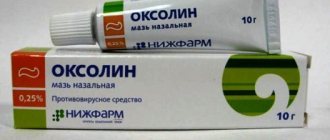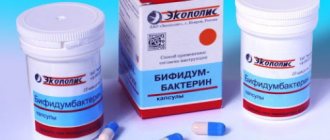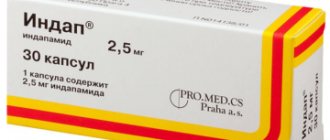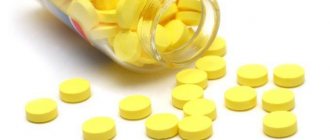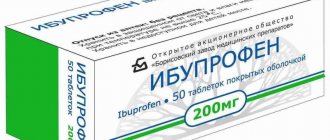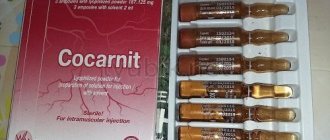"Fluconazole" refers to antifungal drugs used for the prevention and treatment of candidiasis and some other diseases caused by fungal microflora.
This article describes detailed information about the medicine, recommendations for use, contraindications and other information useful for patients.
Release forms
Fluconazole is available in the form of tablets, capsules, solution for intravenous injection, syrup and suppositories.
Capsules
They have a white shell with powder inside. The main active ingredient is fluconazole, the content of which varies from 50 to 150 mg.
Auxiliary components are colloidal silicon dioxide, magnesium stearate, pregelatinized starch, sodium lauryl phosphate, lactose monohydrate.
Capsules are packaged in blisters of 1 or 2 pieces (depending on dosage). Package contains 1 blister.
Solution for injections
A transparent, colorless liquid, sold in volumes of 50-100 ml. 1 ml of the drug includes 2 mg of fluconazole, as well as sodium chloride and water for injection.
Vaginal suppositories
Their action is also based on the antifungal properties of fluconazole. To maintain shape and comfortable administration, the composition includes a fat base and stabilizers.
pharmachologic effect
The instructions for use say that Fluconazole is an inhibitor of the specific synthesis of sterols in fungal cells. The drug belongs to the class of triazole compounds. The active substance is active against Candida microorganisms, pathogens of endemic mycoses, and cryptococci. A specific effect of the drug on fungal enzymes dependent on cytochrome P450 was revealed. The medication inhibits the transformation of fungal cells into ergosterol lanosterol.
Indications for treatment
The medicine is prescribed for mycoses. One of the most common indications for use is candidiasis, including:
- vaginal in acute, recurrent and chronic forms;
- generalized, affecting the respiratory, genitourinary, digestive systems, skin;
- mucous membrane (in the mouth, nasopharynx, eyes, bronchi, esophagus and other locations).
The drug can be included in the therapy of cancer patients and critically ill intensive care patients undergoing antitumor and immunosuppressive treatment.
The medicine also works for:
As a prophylaxis, Fluconazole is prescribed to HIV patients to avoid thrush of the oral mucosa, nasopharynx and esophagus. Also, its use is justified in patients with normal and reduced immunity during treatment with antibiotics.
The dosage and form of use of Fluconazole is determined by a specialist. For local lesions, local exposure is usually chosen: for example, for oral candidiasis in children, a suspension is effective. If the infection recurs, then priority is given to tablets, capsules or injections.
What does Fluconazole help with? Indications for use
Based on the instructions, the drug “Fluconazole” is used in the following cases:
- infectious pathologies caused by candida infection - for example, disseminated tuberculosis, or generalized candidiasis, other variants of invasive candidiasis;
- candiduria;
- non-invasive bronchopulmonary pathologies;
- candidal condition of the mucous membranes - including in the area of the pharynx and oral cavity;
- chronic course of the atrophic or mucocutaneous form of candidiasis of oral tissues - typical for people with dentures;
- cryptococcal infection, for example, meningitis;
- onychomycosis;
- genetic candidiasis - acute course, relapse of the chronic variant;
- prevention of recurrent manifestations of vaginal candidiasis, or candidal balanitis.
The medicine "Fluconazole" - what else does it treat? 150 mg capsules help cope with the following diseases:
- various dermatomycoses, including mycoses of the integumentary tissues of the body, feet or groin area;
- pityriasis versicolor;
- endemic mycoses;
- preventive measures to prevent fungal infections in people who have already undergone radiation therapy.
Self-medication is absolutely unacceptable.
Contraindications
Fluconazole is contraindicated in the following cases:
- Capsules and tablets - for children under 4 years of age;
- Solution for injection - during breastfeeding;
- Hypersensitivity to the active substance and other azole drugs;
- Capsules and tablets that contain milk sugar - problems with the absorption and tolerance of carbohydrates (lactase deficiency, glucose-galactose malabsorption);
- For long-term treatment with a dose of fluconazole 400 mg/day - antihistamines that prolong the QT interval (Terfenadine, Astemizole).
The medicine should be taken with caution when:
- Kidney and liver failure (for injections);
- The appearance of a rash in patients with systemic fungal infection and the superficial form;
- Concomitant use of other hepatotoxic medications;
- Simultaneous administration with the antihistamine “Terfenadine” in a daily dose of up to 400 mg;
- Combined use with acetylsalicylic acid;
- Carrying a child;
- Electrolyte imbalance in the body;
- Heart diseases.
Features of the drug use
The active ability of the drug is based on the ability of the active substance to suppress the production of mycosterols (substances contained in mushrooms). The activity of the drug in relation to various groups of fungi is monitored. The medication Fluconazole instructions for use, which states that the drug has a wide spectrum of action, can be used during pregnancy.
The product can be used during lactation and while taking antibiotics, but only after consultation with a specialist. The medicinal composition is used in the form of tablets and solution for intravenous administration. The pharmacological properties of such drugs do not differ depending on the form of production. The coefficient of biological activity of the drug reaches 90%, this explains the high effectiveness of the product.
The drug can be taken regardless of meals; this does not affect the absorption processes. The active components of the drug accumulate in the stratum corneum of the skin and sweat fluid. Since the elimination of the drug is ensured by the kidneys, taking the composition to patients with disturbances in the functioning of this organ is prohibited.
The mechanism of action of the composition is complex, because Fluconazole in tablets and solution is isolated as a broad-spectrum antifungal agent, which is characterized by increased biological activity.
Is it possible to drink alcohol during the course of treatment with the drug, how does the composition affect pregnancy, and is it prescribed for children? You should try to answer these and other questions.
Instructions for use
According to the annotation for the drug, its dosage and duration of treatment depend on the nature of the fungal infection, the severity of the disease and the individual reaction of the body.
Tablets and capsules can be taken before or after meals with plenty of water.
The solution for infusion is administered intravenously (through a dropper) using any of the following solutions:
- Sodium chloride or potassium chloride (0.9%);
- Sodium bicarbonate (4.2%);
- Dextrose (20%);
- Hartmann's solution (5%);
- Ringer's solution.
If a transition from injection to oral use is intended, the dosage may not be adjusted.
When using candles, you must first carry out hygiene procedures. Suppositories are easily inserted into the vagina (usually done at night). If 2 suppositories per day are prescribed, then after morning use it is advisable to take a horizontal position for half an hour so that the product has time to be adsorbed on the mucous membrane.
Below are the recommended dosages for adults for various fungal infections:
- Thrush: 150 mg once, preventive course - once a month in the same dosage for 4-12 months (if necessary, the doctor may prescribe a larger dose for the course).
- Candidal balanitis : 150 mg at a time.
- Candidiasis of the mucous membranes (except genital): from 50 to 100 mg per day for two weeks to a month.
- Atrophic oral candidiasis (due to wearing dentures): 50 mg per day for two weeks (in parallel, the denture is treated with antiseptics).
- Oropharyngeal candidiasis : up to 100 mg per day once for a week - 10 days (for AIDS, a weekly maintenance dose after the main course is recommended - 150 mg).
- Prevention of candidiasis : from 50 to 400 mg.
- For neutropenia in cancer patients after radiation or chemotherapy - 400 mg per day, starting when neutrophil counts are ≥ 1 thousand / μl and continuing treatment for another week.
- Pityriasis versicolor : 50 mg per day for 2 weeks - a month or 300 mg per week for 14 days.
- Mycosis of the feet and groin : 50 mg per day or 150 mg per week for 14-28 days, sometimes with fungal infections of the feet it is necessary to extend treatment to 6 weeks.
- Endemic deep mycosis : 200 to 400 mg per day for up to 2 years (for example, sporotrichosis can be treated for 1-16 months, histoplasmosis - from 3 to 17 months).
- Onychomycosis: 150 mg per week until the nail is completely changed (approximately 3 - 6 months on the hands and up to a year on the feet). If the infection has been prolonged, the shape of the nail plate may change.
- Invasive candidiasis and cryptococcal infections : 400 mg on the first day, in subsequent days it can be reduced to 200 mg. The duration of treatment is determined by the disease (for example, cryptococcal miningitis requires treatment for at least two months, and in patients with AIDS, long-term maintenance treatment is also required).
Fluconazole tablets: price and analogues
Like all medicines, fluconazole has similar medicinal properties. Replacing this medication with analogues for the treatment of fungal infestations must be agreed upon with the attending physician. Firstly, because self-medication threatens a deterioration in well-being and the occurrence of complications, and secondly, you can make the wrong choice in choosing a drug from the variety of medicinal products offered.
These include:
- Diflucan is an antifungal drug that can be purchased in tablets, capsules, and powder. It has rapid absorption and is well excreted from the body. The recommended dose is 150 mg per day once. If the course of the disease is chronic, then it is used for a long time until relapses stop. Used in the complex treatment of fungal infestations.
- Flucostat is a medicine for fungal infections in the form of capsules and solution. The main component is fluconazole. When administered orally, it is well absorbed, bioavailability is 90%. Depending on the pathology, the minimum dose is 50 mg, the maximum is 400 mg. It is used in the treatment of diseases caused by Candida and Cryptococcus fungi.
Numerous analogues also have properties similar to fluconazole:
- Difluzol, Voritab, Izol.
- Itraconazole, Metrixl, Itracon.
- Oruzol, Flucorus, Itral and others.
The average cost of medications will help you figure out how much fluconazole costs:
- Fluconazole, solution for infusion 2 mg/ml 100 ml bottle No. 1 – 84 rub.
- Fluconazole 50 mg tablet. – 33 – 57 rub.
- Fluconazole 150 mg tablet. – 82 – 134 rub.
- Fluconazole 50 mg No. 1 caps. – 28 – 204 rub.
- Fluconazole 50 mg No. 7 caps. – 63 – 329 rub.
- Fluconazole 50 mg No. 2 caps. – 48 – 89 rub.
Any form of fluconazole is freely available in pharmacies and the drug can be purchased without a doctor’s prescription. The price of a drug depends on the pharmaceutical company producing it, the form of release and volume.
We recommend reading: How to stop biting your nails: useful tips
Adverse reactions
Fluconazole may cause unwanted reactions in the body. Side effects on various systems and organs include:
- Gastrointestinal tract: nausea and vomiting, flatulence, abdominal pain, loss of appetite, changes in taste perception, development of jaundice, elevated liver enzymes due to damage to liver cells or bile outflow.
- Cardiovascular : heart rhythm disturbance.
- CNS: headache, dizziness, fatigue, convulsions (rare).
- Hematopoietic: changes in blood composition (decrease in the level of platelets, neutrophils, leukocytes, granulocytes).
- Immune: itchy skin rash, urticaria, toxic necrolysis, erythrema, Quincke's edema, anaphylactic shock.
, hair loss, impaired renal function, and increased cholesterol have been reported due to taking the drug .
If such symptoms appear, you need to stop taking the medication and contact your doctor to prescribe other medications.
Side effects and signs of overdose
Fluconazole causes side effects extremely rarely. Fluconazole active substance is well tolerated by patients, therefore an inadequate reaction can only manifest itself as a result of the patient’s partial sensitivity to the components of the drug.
Indications for use state that the compatibility of the drug with other medications has not been studied, therefore combination treatment may aggravate the patient’s condition.
The list of possible adverse reactions includes:
- decrease in enzyme concentration;
- various disorders of the digestive system;
- jaundice;
- decreased liver function;
- decrease in heart rate;
- skin reactions;
- bronchial asthma;
- anaphylaxis;
- circulatory disorders;
- changes in blood composition.
You should not drink alcohol while consuming this composition, because people who drank alcohol-containing drinks and underwent treatment more often complained of symptoms of intoxication.
Special instructions
- Therapy should not be interrupted until complete remission, otherwise relapses of the disease are possible.
- Rarely, while taking Fluconazole, toxic changes in the liver developed, including death. Such patients had severe concomitant diseases. Moreover, this did not depend on the dosage, duration of the course, or the age of the patient. In other cases, the changes were reversible, requiring only discontinuation of the drug. If the slightest signs of toxic liver damage appear, the antifungal agent is immediately discontinued.
- Patients infected with AIDS often experience skin reactions. If the infection is superficial, the drug is discontinued; if it is invasive, it is continued under close supervision.
- Fluconazole requires careful combination with Rifabutin, Cisapride and other drugs that affect the cytochrome P450 system.
Genital (vaginal) candidiasis: symptoms, treatment
Every woman has at least once encountered this disease, which is also called thrush. Men are less likely to suffer from this type of candidiasis. Symptoms of vaginal candidiasis are itching, burning, and discomfort in the perineal area. Most often, thrush is accompanied by cheesy discharge or deposits on the mucous membrane. However, in some cases, the discharge may be non-pathological or completely transparent, however, as a rule, it is profuse, irritates the mucous membrane, causing itching and redness, and has an unpleasant odor. Thrush can be caused by a basic lack of hygiene, wearing uncomfortable or artificial underwear for too long, in which the skin does not breathe, as well as poor nutrition, taking antibiotics, or a sharp decrease in immunity (due to stress, illness).
Fluconazole is widely used for thrush. Feedback from patients about it is the most positive: it helps no worse than other means, the effect is felt on the second day, it is easy to use (only 1 time), etc. In addition to using the antifungal agent, it is necessary to maintain a special diet: do not consume sour and dairy products, very spicy or spicy. It is also recommended to use decoctions of chamomile and calendula for washing, which have a calming and anti-inflammatory effect. In case of recurrent candidiasis, it is necessary to increase the frequency of taking the drug Fluconazole (consult your doctor before use).
Drug compatibility
To avoid negative reactions of the body, you should carefully study the compatibility of Fluconazole with other medications:
- With Warfarin - Fluconazole increases prothrombin time by an average of 12%. Monitoring of the indicator is required when combining an antifungal drug and anticoagulants.
- With "Theophylline" in high doses - "Fluconazole" reduces the clearance of the drug from the blood plasma, so careful monitoring of the patient's condition is required to avoid theophylline intoxication.
- With "Rifabutin" - "Fluconazole" increases its concentration in the blood serum, which can lead to inflammation of the uvea (uveitis).
- With Terfenadine and Cisapride - can cause arrhythmia and other unwanted cardiac reactions.
- With hypoglycemic agents (“Glipizide”, “Tolbutamide”, “Chlorpropamide”, etc.) - hypoglycemia may develop in patients with diabetes mellitus, because the half-life of the drug from plasma increases.
- With hydrochlorothiazide - con can increase by 40%.
- With Rifampicin - due to the accelerated elimination of Fluconazole (by about 20%), its dosage should be increased.
- With Medazolam, it increases its concentration, which is fraught with the risk of unwanted psychomotor reactions.
- With "Phenytoin" - increases the concentration of the substance to clinical levels, therefore, adjustment of the dose of "Phenytoin" is required to maintain a therapeutic level in plasma and careful monitoring of these data.
- With Cyclosporine - slowly increases its content in the blood at a dosage of at least 200 mg per day in patients with a kidney transplant.
- With "Zidovudine" - it can provoke increased side effects from taking this medication due to an increase in its concentration in the blood.
- With Tacrolimus, the risk of toxic effects on the kidneys increases.
Pharmacodynamics and pharmacokinetics
After oral administration, fluconazole is well absorbed; food intake does not affect the rate of absorption of fluconazole, its bioavailability is 90%.
- The time to reach maximum concentration after oral administration of 150 mg of the drug on an empty stomach is 0.5–1.5 hours, Cmax is 90% of the plasma concentration when administered intravenously at a dose of 2.5–3.5 mg/l. T1/2 of fluconazole is 30 hours. Communication with plasma proteins is 11–12%. Plasma concentration is directly dependent on dose. A 90% level of equilibrium concentration is achieved by the 4th–5th day of treatment with the drug (when taken once a day).
- Administration of a loading dose (on the first day), 2 times higher than the usual daily dose, allows one to achieve a concentration level corresponding to 90% of the equilibrium concentration by the second day.
- Fluconazole penetrates well into all biological fluids of the body. Concentrations of the active substance in breast milk, joint fluid, saliva, sputum and peritoneal fluid are similar to its levels in plasma. Constant values in vaginal secretions are achieved 8 hours after oral administration and are maintained at this level for at least 24 hours.
- Fluconazole penetrates well into the cerebrospinal fluid (CSF) - with fungal meningitis, the concentration in the CSF is about 85% of its plasma level. In sweat fluid, epidermis and stratum corneum (selective accumulation) concentrations exceeding serum levels are achieved.
- After oral administration of 150 mg on the 7th day, the concentration in the stratum corneum of the skin is 23.4 mcg/g, and 1 week after taking the second dose - 7.1 mcg/g; concentration in nails after 4 months of use at a dose of 150 mg once a week is 4.05 mcg/g in healthy and 1.8 mcg/g in affected nails. The volume of distribution approaches the total water content of the body.
- It is an inhibitor of the CYP2C9 isoenzyme in the liver. It is excreted primarily by the kidneys (80% unchanged, 11% in the form of metabolites). Fluconazole clearance is proportional to creatinine clearance. No fluconazole metabolites were detected in peripheral blood.
The pharmacokinetics of fluconazole depends significantly on the functional state of the kidneys, and there is an inverse relationship between the half-life and creatinine clearance. After hemodialysis for 3 hours, the concentration of fluconazole in plasma decreases by 50%.
Before using fluconazole
Some medical conditions may interact with fluconazole. Tell your doctor if you have any health problems, such as:
- during pregnancy, planning pregnancy or breastfeeding;
- if you are taking any prescription or over-the-counter medications, herbal preparations or dietary supplements;
- if you are allergic to medications, food or other substances;
- if you have had an allergic reaction to another azole antifungal (such as itraconazole);
- if you have had problems with your liver, kidneys, or heart (eg, rhythm problems, structural heart problems);
- if you have a weakened immune system, HIV infection, diabetes, cancer, or blood electrolyte problems (low potassium or magnesium levels).
Use fluconazole as directed by your doctor. Take it orally with or without food. Fluconazole is taken at least 2 hours before a PPI (eg, omeprazole). To completely recover from an infection, the course of treatment must be complete. Continue taking it even if you feel better in a few days. You cannot skip a dose.
Fluconazole works best when taken at the same time every day. If you miss a dose, take it as soon as possible. If it is near your next dose, skip the missed dose and return to your scheduled dosing. Do not take a double dose at once.
Consult your doctor with any questions you have.
Safety Information
Fluconazole may cause dizziness. This effect may be worsened if you take the drug with alcohol or certain medications. Use fluconazole with caution. Don't drive or do other possibly dangerous tasks until you know how you react to it.
Rarely, fluconazole has caused serious liver damage, including death, mainly in patients with severe illness. Liver damage was not related to the total daily dose, duration of therapy, gender or age of the patient. It may or may not be reversible when the drug is stopped. Call your doctor if you have problems such as dark urine, loss of appetite, pale stools, severe abdominal pain, or yellowing of the skin or eyes.
If symptoms do not improve within a few days or if they worsen, consult a specialist.
Fluconazole only acts against fungi. It cannot be used to treat a viral (such as a cold) or bacterial infection.
Tell your doctor that you are being treated with fluconazole before you receive any medical or dental care, emergency care, or surgery.
Prolonged or repeated use of fluconazole may lead to secondary infection. Tell your doctor about this. The medication may need to be changed.
Hormonal contraceptives may not be as effective when taking fluconazole. To prevent pregnancy, use additional forms of birth control (such as condoms).
Laboratory tests, including liver and kidney function, may be done during treatment with fluconazole. They help monitor your condition or detect unwanted effects.
All medications can cause negative effects, but many patients experience none or only mild ones. Check with your doctor if any of these most common side effects persist or bother you:
- taste changes;
- diarrhea;
- dizziness;
- headache;
- stomach upset;
- mild abdominal pain;
- nausea;
- vomit.
Contact a healthcare professional right away if you notice any of these serious side effects:
- serious allergic reactions (rash; difficulty breathing; itching; chest tightness; swelling of the mouth, face, lips, or tongue; unusual wheezing);
- dark color of urine;
- burning, numbness or tingling sensations in the skin;
- fever, chills, or persistent sore throat;
- arrhythmia;
- loss of appetite;
- pale stool;
- muscle pain, weakness or cramps;
- red, swollen, blistered, or peeling skin;
- convulsions;
- severe or persistent diarrhea, nausea, or vomiting;
- swelling of the hands;
- unusual bruising or bleeding; unusual or severe abdominal pain;
- unusual tiredness;
- yellowing of the skin or eyes.
This is not a complete list of all negative effects that may occur. If you have questions, contact your doctor.
Store fluconazole at a temperature not exceeding 30 degrees, away from heat, moisture and light. Do not store in the bathroom or in places accessible to children and pets.
Fluconazole can only be treated by someone who has been prescribed it by a doctor. Do not share your medicine with other people.
Drug interactions with other drugs
If, at the time of treatment, the patient is taking any antihistamines, antifungals, antibiotics, drugs for stomach upset, arrhythmias, or is being treated for mental disorders, it is necessary to notify the attending physician.
The following effects are likely:
- Taking Fluconazole and Cisapride disrupts the functioning of the heart.
- Combination with Terfenadine leads to arrhythmia.
- Combination with Astemizole or Quindin promotes the development of ventricular tachycardia.
- Erythromycin and Fluconazole together cause cardiotoxicity.
Careful monitoring requires the condition of a person who combines the use of Fluconazole with anticoagulant drugs, HMG-Coa reductase inhibitors, as well as oral contraceptives.
Video about fluconazole
Side effects of fluconazosis
In addition to its desired effects, the drug may cause unwanted ones. If this happens, you may need to get help from a doctor. So, you should immediately contact a specialist if any of these undesirable effects occur while taking fluconazole:
Rare
- pain in the stomach or abdomen;
- shiver;
- clay-colored chair;
- cough;
- dark urine;
- diarrhea;
- difficulty swallowing;
- drowsiness;
- cardiopalmus;
- heat;
- general weakness or lethargy;
- headache;
- nausea and vomiting;
- hives, itching, or skin rash;
- widespread swelling of the mouth, eyelids, lips, tongue, throat, arms, legs, feet, or genitals;
- light-colored chair;
- loss of appetite;
- swelling of the eyelids or skin around the eyes, face, lips, or tongue;
- persistent stomach pain;
- tightness in the chest;
- bad breath;
- unusual tiredness or lethargy;
- vomiting blood;
- pain in the stomach or upper right abdomen;
- yellow eyes and skin.
Prevalence unknown
- black, tarry stools;
- skin blistering or peeling;
- chest pain or discomfort;
- convulsions;
- decrease in urine volume;
- feeling of dry mouth;
- fainting;
- hoarseness;
- increased thirst;
- irregular or slow heart rate;
- joint or muscle pain;
- loss of bladder control;
- pain in the lower back or side;
- mood changes;
- muscle pain or cramps;
- muscle spasms or twitching in all limbs;
- numbness or tingling in your arms, legs, or lips;
- painful or difficult urination;
- paleness of the skin;
- red sores on the skin, often with a purple center;
- red, irritated eyes;
- sore throat;
- sores, sores, or white spots in the mouth or lips;
- sudden loss of consciousness;
- swollen tonsils;
- unusual bleeding or bruising.
If any of the following signs of overdose occur while taking fluconazole, seek emergency help immediately:
Fearfulness, suspiciousness or other mental changes, paranoid behavior, and visual, auditory or tactile hallucinations.
In case of overdose, symptomatic treatment should be carried out (with auxiliary measures and gastric lavage if clinically indicated). Fluconazole is primarily excreted in the urine. A three-hour hemodialysis session reduces plasma levels by approximately 50%.
Minor Side Effects
Some side effects that may occur during treatment with fluconazole may not require medical attention. Once the body gets used to the medicine, these effects may subside. You can find out from your doctor how to reduce or prevent some of them. If any of the following side effects persist, bother you, or if you have questions about them, consult your doctor:
Less common
- increased stomach acidity;
- changes in taste or bad, unusual or unpleasant aftertaste;
- belching;
- heartburn;
- indigestion;
- stomach upset or discomfort.
Prevalence unknown
- hair loss or thinning hair.
Information for specialists
This drug is usually well tolerated. Changes in kidney and blood function tests have been reported in some patients, primarily those with serious underlying medical conditions (eg, AIDS, cancer); the clinical significance and relationship to therapy remain unclear.
Nervous system
Rare cases of seizures have been reported, but causation is difficult to establish as some of these patients had cryptococcal meningitis or severe underlying disease.
Convulsions, dizziness, paresthesia, somnolence, tremor, dizziness have also been reported during post-marketing experience.
- Very common (10% or more): headache (up to 13%).
- Uncommon (0.1-1%): convulsions, dizziness, paresthesia, drowsiness, dizziness, visual disturbances, taste changes, hyperkinesia, hypertension.
- Rare (less than 0.1%): tremor.
- Frequency not reported: dysesthesia.
Gastrointestinal tract
- Very common (10% or more): nausea, abdominal pain, diarrhea, vomiting.
- Common (1-10%): dyspepsia.
- Uncommon (0.1-1%): constipation, flatulence, loose stools, dry mouth.
- Frequency not reported: General abdominal discomfort.
Dry mouth, dyspepsia and vomiting have also been reported during post-marketing experience.
Liver
Fatal hepatic reactions occur mainly in patients with serious concomitant diseases (primarily AIDS or malignant tumors) and often while taking multiple concomitant medications. One patient with AIDS experienced acute liver necrosis and liver failure approximately 3 weeks after starting this drug.
Transient hepatic reactions have been reported in patients without other identifiable risk factors. Liver function returns to baseline when treatment with this drug is stopped.
An increase in serum transaminase levels and a statistically significant increase in AST were recorded. The first phenomenon occurred mainly in patients with severe concomitant diseases (primarily AIDS or malignant tumors) and often while taking concomitant medications, including hepatotoxic agents.
An increase in transaminase levels above 2-3 x ULN has also been reported.
Cholestasis, liver injury, and hepatocellular necrosis have also been reported during post-marketing experience.
- Very common (10% or more): increased ALT, increased AST.
- Uncommon (0.1% to 1%): increased serum transaminases, cholestasis, jaundice, increased bilirubin.
- Rare (less than 0.1%): severe liver reactions, liver toxicity (including fatal), liver failure, hepatitis, hepatocellular necrosis, hepatocellular damage.
- Frequency not reported: Hepatic reactions (from mild transient increases in transaminase levels to clinical hepatitis, fulminant liver failure (including fatal)), transient hepatic reactions (hepatitis, jaundice), elevated liver function tests (transient and asymptomatic), cholestatic jaundice, fatal liver necrosis, increased concentrations of liver enzymes in plasma.
Skin
Reversible alopecia is associated with long-term (2 months or longer) therapy.
In patients with serious underlying diseases (primarily AIDS and malignancies), exfoliative skin diseases have been fatal.
Acute generalized exanthematous pustulosis, toxicerma, excessive sweating, exfoliative skin diseases (including Stevens-Johnson syndrome, toxic epidermal necrolysis) and alopecia have also been reported during post-marketing experience.
- Very common (10% or more): rash.
- Common (1-10%): maculopapular erythema.
- Uncommon (0.1-1%): itching, genital pruritus, erythematous rash, dry skin, unusual skin odor, urticaria, herpes simplex virus, toxicoderma, increased sweating.
- Rare (less than 0.1%): Quincke's edema, exfoliative skin diseases (including toxic epidermal necrolysis, Stevens-Johnson syndrome), acute generalized exanthematous pustulosis, alopecia, exfoliative dermatitis.
Frequency not reported: reversible alopecia, exfoliative skin lesions (including fatalities).
Metabolism
- Very common (10% or more): increased blood alkaline phosphatases.
- Uncommon (0.1% to 1%): hypokalemia, loss of appetite, decreased appetite.
- Rare (less than 0.1%): hypercholesterolemia, hypertriglyceridemia.
Hypercholesterolemia, hypertriglyceridemia, hypokalemia have also been reported during post-marketing experience.
Increased sensitivity
Rare cases of exfoliative dermatitis and ulcerative eruptions consistent with Stevens-Johnson syndrome have been reported in association with hypersensitivity reactions.
- Rare (less than 0.1%): anaphylactic reactions, anaphylactic shock.
- Frequency not reported: hypersensitivity reactions (including generalized edema, stridor, hypotension, exfoliative dermatitis, ulcerative rashes), fixed toxicoderma.
Post-marketing reports: anaphylaxis (including angioedema, facial edema, pruritus).
Heart and blood vessels
Most reports of QT prolongation and torsade de pointes (TdP) have occurred in critically ill patients with multiple risk factors, such as structural heart disease, electrolyte abnormalities, and those taking other medications that might contribute.
QT prolongation and torsade de pointes (TdP) have also been reported during post-marketing experience.
- Rare (less than 0.1%): QT interval prolongation, torsade de pointes.
- Frequency not reported: prolongation of the QT interval on the ECG, palpitations, complex ventricular arrhythmia.
Hematological
While taking fluconazole, anemia, eosinophilia, leukopenia, neutropenia and thrombocytopenia may develop. This often occurs in patients with severe deep fungal infections or an underlying disease.
Spontaneous reports of anemia were more common in patients 65 years of age or older than in younger patients. However, there has been a natural increase in the incidence of anemia in older people. A causal relationship to the effects of the drug cannot be determined.
- Uncommon (0.1-1%): anemia.
- Rare (less than 0.1%): leukopenia, agranulocytosis, neutropenia, thrombocytopenia.
- Frequency not reported: eosinophilia
Other
- Uncommon (0.1-1%): thirst, fatigue, malaise, pain, chills, asthenia, fever, hot flashes.
- Rare (less than 0.1%): facial swelling.
- Frequency not reported: infection caused by resistant microorganisms.
Fever, asthenia, fatigue and general malaise were also mentioned during post-sale experiences.
Musculoskeletal system
- Uncommon (0.1% to 1%): back pain, myalgia.
- Frequency not reported: Joint pain, stiff fingers.
Myalgia has also been reported during post-marketing experience.
Psyche
- Uncommon (0.1-1%): insomnia, nervousness.
Insomnia has also been reported during post-marketing experience.
Kidneys
- Uncommon (0.1-1%): polyuria, kidney pain, changes in renal function tests.
- Frequency not reported: membranous nephropathy.
Spontaneous reports of acute renal failure were more common in patients 65 years of age or older than in younger patients. However, there has been a natural increase in the incidence of kidney failure in older adults. A causal relationship to the effects of the drug cannot be determined.
Genitourinary system
- Uncommon (0.1-1%): intermenstrual bleeding, dysmenorrhea, leucorrhoea, menorrhagia, uterine cramps, vaginal disorders, female sexual dysfunction.
Respiratory system
- Uncommon (0.1-1%): pharyngitis.
- Frequency not reported: respiratory tract diseases.
Vision
- Uncommon (0.1-1%): abnormal vision.
Fluconazole - instructions for use
| FOR ADULTS | ||
| Indication | Dosage | Comments |
| Vaginal candidiasis | 150 mg orally as a single dose | Recommended as preferred therapy. If relapses are frequent or severe, suppressive therapy is usually not recommended. |
| Stomatitis | ||
| Oropharyngeal candidiasis | 200 mg IV or PO on day 1, then 100 mg IV or PO once daily Duration of therapy: at least 2 weeks to reduce the risk of relapse | Recommended as preferred therapy. If relapses are frequent or severe, suppressive therapy is usually not recommended |
| Candedymia | Doses up to 400 mg/day | The optimal therapeutic dose and duration of therapy have not been established. Application: for systemic candidiasis, including candidemia, disseminated candidiasis and pneumonia |
| Fungal pneumonia | Doses up to 400 mg/day | The optimal therapeutic dose and duration of therapy have not been established. Application: for systemic candidiasis, including candidemia, disseminated candidiasis and pneumonia |
| Disseminated fungal infection | Doses up to 400 mg/day | The optimal therapeutic dose and duration of therapy have not been established. Application: for systemic candidiasis, including candidemia, disseminated candidiasis and pneumonia |
| Systemic candidiasis | Doses up to 400 mg/day | The optimal therapeutic dose and duration of therapy have not been established. Application: for systemic candidiasis, including candidemia, disseminated candidiasis and pneumonia |
| Candidiasis of the esophagus | 200 mg IV or PO on day 1 followed by 100 mg IV or PO once daily Duration of therapy: At least 3 weeks, then another 2 weeks after symptoms disappear | Doses up to 400 mg/day may be used based on clinical assessment of patient response. |
| Candidiasis of the urinary tract | 50 to 200 mg IV or orally once daily | For the treatment of urinary tract candidiasis and peritonitis |
| Fungal peritonitis | 50 to 200 mg IV or orally once daily | For the treatment of urinary tract candidiasis and peritonitis |
| Cryptococcal meningitis in an immunocompetent host | Acute infections: 400 mg IV or PO on day 1, followed by 200 mg IV or PO once daily Duration of therapy: 10 to 12 weeks after CSF culture is negative | Doses of 400 mg IV or PO once daily may be used based on clinical assessment of patient response |
| Cryptococcal meningitis in an immunocompromised host | Acute infections: 400 mg IV or PO on day 1, followed by 200 mg IV or PO once daily Duration of therapy: 10 to 12 weeks after CSF culture is negative | Doses of 400 mg IV or PO once daily may be used based on clinical assessment of patient response. Suppression of exacerbations in patients with AIDS: 200 mg IV or PO once. |
| Cryptococcosis | 400 mg orally once daily for 6 to 12 months | |
| Prevention of fungal infection | 400 mg orally once daily Duration of therapy: 7 days after the neutrophil count rises above 1000 cells/mm3 | |
| Coccidioidomycosis – meningitis | 400 mg orally once daily | Some experts start therapy with 800-1000 mg/day If there is a good response to therapy, it should be continued indefinitely. |
| Onychomycosis on fingernails | 150-300 mg orally once weekly Duration of therapy: 3-6 months | |
| Onychomycosis on toenails | 150-300 mg orally once weekly Duration of therapy: 6-12 months | |
| FOR CHILDREN | ||
| Candidiasis of the esophagus | 2 weeks or younger (gestational age 26–29 weeks): 3 mg/kg IV or PO every 72 hours Over 2 weeks: 6 mg/kg IV or PO on day 1, then 3 mg/kg IV or PO once daily Duration of therapy: at least 3 weeks and at least another 2 weeks after symptoms have resolved | A dose of 12 mg/kg IV or PO once daily may be used in patients older than 2 weeks of age based on clinical assessment of patient response. This corresponds to 12 mg/kg/72 hours in preterm infants in the first 2 weeks of life |
| Stomatitis | 2 weeks or younger (gestational age 26–29 weeks): 3 mg/kg IV or PO every 72 hours Over 2 weeks: 6 mg/kg IV or PO on day 1, then 3 mg/kg IV or PO once daily Duration of therapy: at least 2 weeks to reduce the risk of exacerbation | |
| Candidemia | 2 weeks or younger (gestational age 26–29 weeks): 6–12 mg/kg IV or PO every 72 hours Over 2 weeks: 6-12 mg/kg IV or PO | Application: for the treatment of candidemia and disseminated candidiasis |
| Disseminated fungal infection | 2 weeks or younger (gestational age 26–29 weeks): 6–12 mg/kg IV or PO every 72 hours Over 2 weeks: 6-12 mg/kg IV or PO | Application: for the treatment of candidemia and disseminated candidiasis |
| Systemic candidiasis | 2 weeks or younger (gestational age 26–29 weeks): 6–12 mg/kg IV or PO every 72 hours Over 2 weeks: 6-12 mg/kg IV or PO | Application: for the treatment of candidemia and disseminated candidiasis |
| Cryptococcal meningitis in an immunocompetent host | Acute infections: 2 weeks or younger (gestational age 26–29 weeks): 6 mg/kg IV or PO every 72 hours Over 2 weeks: 12 mg/kg IV or PO on day 1, then 6 mg/kg IV or PO once daily Duration of therapy: 10 to 12 weeks after CSF culture is negative | A dose of 12 mg/kg IV or PO once daily may be used in patients older than 2 weeks of age based on clinical assessment of patient response. This corresponds to 12 mg/kg IV or PO every 72 hours in preterm infants during the first 2 weeks of life. |
| Cryptococcal meningitis in an immunocompromised host | Acute infections: 2 weeks or younger (gestational age 26–29 weeks): 6 mg/kg IV or PO every 72 hours Over 2 weeks: 12 mg/kg IV or PO on day 1, then 6 mg/kg IV or PO once daily Duration of therapy: 10 to 12 weeks after CSF culture is negative | A dose of 12 mg/kg IV or PO once daily may be used in patients older than 2 weeks of age based on clinical assessment of patient response. This corresponds to 12 mg/kg IV or PO every 72 hours in preterm neonates during the first 2 weeks of life. Suppression of exacerbations in children with AIDS: 6 mg/kg orally once daily |
| Renal dose adjustment | Renal dose adjustment Adults: Single-dose therapy: no adjustment recommended. Multiple dose: creatinine clearance 50 mL/minute or less (without dialysis): 50 to 400 mg IV or PO as a loading dose followed by 50% of the usual daily dose (as indicated) Children: Dose reduction is similar to recommendations for adults. | Use with caution Depending on the clinical condition, further dose adjustment may be required. |
| Hepatic dose adjustment | Done with care | |
| Dialysis | Adults: No adjustment is recommended for a single dose. For multiple dosing: 50 to 400 mg IV or PO as a loading dose, followed by 100% of the usual daily dose (as indicated) after each dialysis session. On days when dialysis is not performed, the dose should be reduced accordingly. Children: Dose reduction is similar to recommendations for adults. Additional adjustments may be required depending on the clinical condition. | |
| Other comments | A loading dose of twice the daily dose on the first day of therapy is recommended to achieve plasma levels nearly equal to the static state on the second day of therapy. Can be administered orally or by intravenous infusion; can be taken regardless of meals. Do not use absolute doses exceeding 600 mg/day in children; pediatric doses of 3, 6, and 12 mg/kg generally correspond to adult doses of 100, 200, and 400 mg, respectively. Intravenous infusion should be administered at a maximum rate of approximately 200 mg/hour as a continuous infusion. Shake oral suspension well before use; Throw away any unused medication after 2 weeks. Determine the daily dose based on the patient's condition and response to therapy. Continue therapy until clinical parameters or laboratory tests indicate that the active fungal infection has subsided. Insufficient duration of therapy may lead to recurrence of active infection. | |
| Monitoring | Dermatological signs: with progression of lesions in patients with invasive/systemic fungal infections that cause rash. Liver: For more severe liver damage, patients with abnormal liver function test results should be monitored for signs/symptoms of liver disease associated with treatment with this drug. Kidneys: monitoring renal function in elderly patients. | |
| Recommendation for patients | Sometimes you may experience dizziness or convulsions - this point should be taken into account if you need to drive a car or operate complex machinery. | |
Drug and disease interactions
Drugs tested in combination with fluconazole:
- Advair discus (fluticasone/salmeterol);
- aspirin;
- Benadryl (diphenhydramine);
- fish oil (omega-3 polyunsaturated fatty acids);
- Cymbalta (duloxetine);
- Flexeril (cyclobenzaprine);
- Lyrica (pregabalin);
- Nexium (esomeprazole);
- Norco (acetaminophen/hydrocodone);
- singulair (montelukast);
- ProAir HFA (albuterol);
- Spiriva (tiotropium);
- synthroid (levothyroxine);
- taflenol (acetaminophen);
- vitamin B12 (cyanocobalamin);
- vitamin C (ascorbic acid);
- vitamin D3 (cholecalciferol);
- zofran (ondansetron);
- Xanax (alprazolam);
- Zyrtec (cetirizine).
Interaction with diseases
- hepatotoxicity;
- hemodialysis;
- renal dysfunction.


